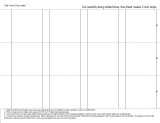
4
Using a List in a Calculation .....................................................................................................................55
Using a List to Assign Different Values to Multiple Variables ................................................................... 55
2-5 Matrix and Vector Calculations .............................................................................................56
Inputting Matrix Data ................................................................................................................................ 56
Performing Matrix Calculations ................................................................................................................ 56
Using a Matrix to Assign Different Values to Multiple Variables ...............................................................57
2-6 Specifying a Number Base ....................................................................................................57
Binary, Octal, Decimal, and Hexadecimal Calculation Ranges ................................................................ 57
Selecting a Number Base.........................................................................................................................58
Arithmetic Operations ............................................................................................................................... 58
Bitwise Operations ...................................................................................................................................58
Using the baseConvert Function (Number System Transform) ............................................................... 59
2-7 Using the Action Menu ...........................................................................................................59
Abbreviations and Punctuation Used in This Section ...............................................................................59
Example Screenshots ..............................................................................................................................60
Using the Transformation Submenu .........................................................................................................60
Using the Advanced Submenu ................................................................................................................. 62
Using the Calculation Submenu ...............................................................................................................65
Using the Complex Submenu ...................................................................................................................67
Using the List-Create Submenu ............................................................................................................... 69
Using the List-Statistics and List-Calculation Submenus ......................................................................... 70
Using the Matrix-Create Submenu ........................................................................................................... 73
Using the Matrix-Calculation and Matrix-Row&Column Submenus .........................................................74
Using the Vector Submenu ......................................................................................................................77
Using the Equation/Inequality Submenu ................................................................................................. 79
Using the Assistant Submenu .................................................................................................................. 82
Using the Distribution/Inv.Dist Submenu .................................................................................................. 82
Using the Financial Submenu ..................................................................................................................88
Using the Command Submenu ................................................................................................................ 88
2-8 Using the Interactive Menu ...................................................................................................89
Interactive Menu Example ........................................................................................................................ 89
Using the “apply” Command .....................................................................................................................89
2-9 Using the Main Application in Combination with Other Applications ...............................89
Using Another Application’s Window ........................................................................................................90
Using the Stat Editor Window ...................................................................................................................90
Using the Geometry Window ....................................................................................................................91
2-10 Using Verify ...........................................................................................................................92
2-11 Using Probability ..................................................................................................................92
2-12 Running a Program in the Main Application ......................................................................93
Chapter 3: Graph & Table Application ............................................................................... 95
Graph & Table Application-Specific Menus and Buttons ..........................................................................95
3-1 Storing Functions ...................................................................................................................97
Using Graph Editor Sheets.......................................................................................................................97
Storing a Function .................................................................................................................................... 97
Graphing a Stored Function ..................................................................................................................... 98
Shading the Region Bounded by Two Expressions ................................................................................. 99
Overlaying Two Inequalities in an Intersection Plot / Union Plot .............................................................. 99
Saving Graph Editor Data to Graph Memory ......................................................................................... 100
3-2 Using the Graph Window .....................................................................................................100
Configuring View Window Parameters for the Graph Window ............................................................... 100
Using View Window Memory ..................................................................................................................102
Panning the Graph Window ...................................................................................................................103




















